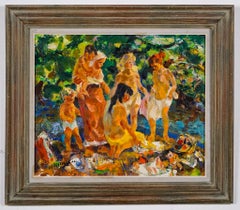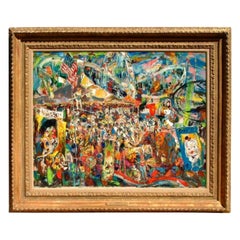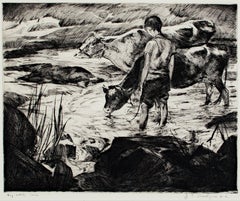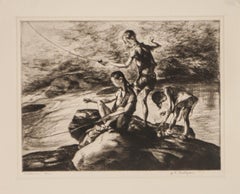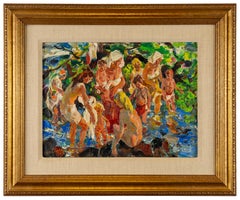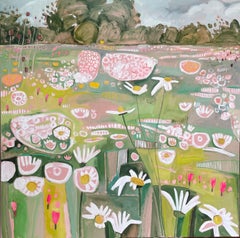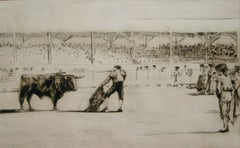John Edward Costigan Art
American, 1888-1972
An American Painter Compositional painter of figures and country animals; watercolor painter Costigan was a largely self-taught artist. He moved from Providence, Rhode Island to New York City as an orphaned teenager in 1904 to work for a commercial poster company. It was here that he learned the rudiments of drawing and painting, skills he furthered with informal study at New York's Kit Kat Club, a popular artists' hangout. Costigan achieved national fame as a painter and printmaker in the1920s and 30s. He won numerous prestigious awards and, despite his lack of formal artistic training, was elected a full member of the National Academy of Design. In 1937 the Smithsonian Institution held a one-person exhibition of his graphic works. Famed American printmaker John Taylor Arms praised Costigan as "a brilliant etcher, particularly noted for his interpretation of life on the American farmstead." Today prints by Costigan can be found in private and public collections around the nation, including the Prints and Photographs Division of the Library of Congress in Washington, which owns twenty-two. The Swope exhibition is the largest devoted to Costigan's work since the late 1960s. Many of the forty-five prints in the exhibition are from the Swope's own extensive holdings of Costigan's works. Other are being lent by private collectors from around the country.to
1
5
1
1
1
Overall Width
to
Overall Height
to
9
2
1
2
4
1
9
7
5
5
4
2
1
1
1
5
4
3
1
1
10
7,820
5,167
2,504
1,501
5
9
Artist: John Edward Costigan
Bathers
By John Edward Costigan
Located in Sheffield, MA
John Edward Costigan, N.A.
American, 1888-1972
Bathers
Oil on canvas
Signed ‘J.E. Costigan N.A.’ lower left
20 by 24 in. W/frame 26 by 30 in.
John Costigan was born of Irish-American parents in Providence, Rhode Island, February 29, 1888. He was a cousin of the noted American showman, George M. Cohan, whose parents brought the young Costigan to New York City and was instrumental in starting him on a career in the visual arts. They were less successful in encouraging him to pursue formal studies at the Art Students League (where, however, he later taught) than in exposing him to the commercial art world through the job they had gotten him with the New York lithographing firm that made their theatrical posters.
At the H. C. Miner Lithographing Company, Costigan worked his way up from his entry job as a pressroom helper, through various apprenticeships, to the position of sketch artist. In the latter capacity he was an uncredited designer of posters for the Ziegfeld Follies and for numerous silent films. Meanwhile, he had supplemented his very meager formal studies in the fine arts with a self-teaching discipline that led to his first professional recognition in 1920 with the receipt of prizes for an oil painting and watercolor in separate New York exhibitions.
A year earlier, Costigan had wed professional model Ida Blessin, with whom he established residence and began raising a family in the sleepy little rural New York hamlet of Orangeburg, the setting for the many idyllic farm landscapes and wood interiors with which he was to become identified in a career that would span half a century.
John Costigan’s first national recognition came in 1922 with his winning of the coveted Peterson Purchase prize of the Art Institute of Chicago for an oil on canvas, “Sheep at the Brook.” It marked the start of an unbroken winning streak that would gain him at least one important prize per year for the remainder of the decade. The nation’s art journalists and critics began to take notice, making him the recurring subject of newspaper features and magazine articles. The eminent author and critic Edgar Holger Cahill was just a fledgling reporter when he wrote his first feature, “John Costigan Carries the Flame,” for Shadowland Magazine in 1922. Costigan had his first one-man show of paintings at the Rehn Gallery on New York’s 5th Avenue in November, 1924, to be followed less than three years later by another at the Art Institute of Chicago. In addition, Costigan’s work has been—and continues to be included, side-by-side with that of some of America’s most high-profile artists, in museum and gallery exhibitions throughout the country. His renown had peaked in the early 1930s, by which time his work had been honored with nearly every major award then being bestowed in the fine arts and had been acquired for the permanent collections of several prestigious American museums, including New York’s Metropolitan (which only recently, in 1997, deaccessioned his “Wood Interior,” acquired in 1934).
Although Costigan’s celebrity had ebbed by the late 1930s, the Smithsonian Institution saw fit in 1937 to host an exhibition exclusively of his etchings. And, in 1941, the Corcoran Gallery (also Washington, D.C.) similarly honored him for his watercolors. (Another Washington institution, the Library of Congress, today includes 22 Costigan etchings and lithographs in its permanent print collection.)
During World War II, Costigan returned briefly to illustrating, mainly for Bluebook, a men’s pulp adventure magazine. A gradual revival of interest in his more serious work began at the end of the war, culminating in 1968 with the mounting of a 50-year Costigan retrospective at the Paine Art Center and Arboretum in Oshkosh, Wisconsin. Oils, watercolors and prints were borrowed from museums and private collections throughout the country, and the exhibition was subsequently toured nationally by the Smithsonian Institution.
John Costigan died of pneumonia in Nyack, NY, August 5, 1972, just months after receiving his final prestigious award —the Benjamin West Clinedinst Medal of the Artist’s Fellowship, Inc., presented in general recognition of his “...achievement of exceptional artistic merit...” in the various media he had mastered in the course of his career.
This painting depicts one of the artist's favorite themes --the farm family bathing...
Category
1950s Post-Impressionist John Edward Costigan Art
Materials
Oil
John Edward Costigan Painting, circa 1950's - Carnival
By John Edward Costigan
Located in Phoenix, AZ
John Costigan (1888-1972) oil on canvas, circa: 1950s. In excellent condition.
Exciting Expressionist Painting of a lively Carnival Scene. Signed lower right: ''J.E. Costigan",
Title...
Category
Mid-20th Century John Edward Costigan Art
Materials
Paint
20th century drypoint etching figurative animal print black and white signed
By John Edward Costigan
Located in Milwaukee, WI
"Boy With Cows" is an original drypoint etching by John Edward Costigan. It depicts a young boy with three cows standing in a watering hole. The artist si...
Category
1930s American Realist John Edward Costigan Art
Materials
Drypoint, Etching
Fisherman Three 1939 original signed etching by John E. Costigan
By John Edward Costigan
Located in Paonia, CO
Fisherman Three is an original 1939 signed etching by the American artist John E. Costigan
( 1888-1972 ) a self-taught painter and printmaker. The locale for Costigan...
Category
Mid-20th Century Other Art Style John Edward Costigan Art
Materials
Etching
Bathing Group
By John Edward Costigan
Located in Sheffield, MA
John Edward Costigan
American, 1888-1972
Bathing Group
Oil on canvas board
12 by 16 in, w/ frame 19 by 23 in
Signed ‘J.E. Costigan N.A.’ lower left
John Costigan was born of Irish-...
Category
Mid-20th Century Modern John Edward Costigan Art
Materials
Oil
Group of Workers
By John Edward Costigan
Located in San Francisco, CA
This artwork titled "Group of Workers" 1943, is an original lithograph on paper by noted American artist John Edward Costigan, 1888-1972. It is hand signed and titled in pencil by th...
Category
Mid-20th Century Realist John Edward Costigan Art
Materials
Lithograph
"When Day is Done, " an Original Etching signed by John Edward Costigan
By John Edward Costigan
Located in Milwaukee, WI
"When Day is Done" is an original etching and aquatint signed lower right in pencil by the artist John Edward Costigan. It depicts a man and a woman with their young child at the end...
Category
1930s Post-Impressionist John Edward Costigan Art
Materials
Etching, Aquatint
Bathing Group
By John Edward Costigan
Located in Sheffield, MA
John Edward Costigan, N.A.
American, 1888-1972
Bathing Group
Oil on canvas board
Signed ‘J.E. Costigan N.A.’ lower left
12 by 16 in. W/frame 20 by 24 i...
Category
1950s Post-Impressionist John Edward Costigan Art
Materials
Oil
Woman and Child
By John Edward Costigan
Located in Sheffield, MA
John Edward Costigan, N.A.
American, 1888-1972
Woman and Child
Oil on canvas
Signed ‘J.E. Costigan N.A.’ lower left
24 by 30 in. W/frame 32 by 38 in.
John Costigan was born of Irish-American parents in Providence, Rhode Island, February 29, 1888. He was a cousin of the noted American showman, George M. Cohan, whose parents brought the young Costigan to New York City and was instrumental in starting him on a career in the visual arts. They were less successful in encouraging him to pursue formal studies at the Art Students League (where, however, he later taught) than in exposing him to the commercial art world through the job they had gotten him with the New York lithographing firm that made their theatrical posters.
At the H. C. Miner Lithographing Company, Costigan worked his way up from his entry job as a pressroom helper, through various apprenticeships, to the position of sketch artist. In the latter capacity he was an uncredited designer of posters for the Ziegfeld Follies and for numerous silent films. Meanwhile, he had supplemented his very meager formal studies in the fine arts with a self-teaching discipline that led to his first professional recognition in 1920 with the receipt of prizes for an oil painting and watercolor in separate New York exhibitions.
A year earlier, Costigan had wed professional model Ida Blessin, with whom he established residence and began raising a family in the sleepy little rural New York hamlet of Orangeburg, the setting for the many idyllic farm landscapes and wood interiors with which he was to become identified in a career that would span half a century.
John Costigan’s first national recognition came in 1922 with his winning of the coveted Peterson Purchase prize of the Art Institute of Chicago for an oil on canvas, “Sheep at the Brook.” It marked the start of an unbroken winning streak that would gain him at least one important prize per year for the remainder of the decade. The nation’s art journalists and critics began to take notice, making him the recurring subject of newspaper features and magazine articles. The eminent author and critic Edgar Holger Cahill was just a fledgling reporter when he wrote his first feature, “John Costigan Carries the Flame,” for Shadowland Magazine in 1922. Costigan had his first one-man show of paintings at the Rehn Gallery on New York’s 5th Avenue in November, 1924, to be followed less than three years later by another at the Art Institute of Chicago. In addition, Costigan’s work has been—and continues to be included, side-by-side with that of some of America’s most high-profile artists, in museum and gallery exhibitions throughout the country. His renown had peaked in the early 1930s, by which time his work had been honored with nearly every major award then being bestowed in the fine arts and had been acquired for the permanent collections of several prestigious American museums, including New York’s Metropolitan (which only recently, in 1997, deaccessioned his “Wood Interior,” acquired in 1934).
Although Costigan’s celebrity had ebbed by the late 1930s, the Smithsonian Institution saw fit in 1937 to host an exhibition exclusively of his etchings. And, in 1941, the Corcoran Gallery (also Washington, D.C.) similarly honored him for his watercolors. (Another Washington institution, the Library of Congress, today includes 22 Costigan etchings and lithographs in its permanent print collection.)
During World War II, Costigan returned briefly to illustrating, mainly for Bluebook, a men’s pulp adventure magazine. A gradual revival of interest in his more serious work began at the end of the war, culminating in 1968 with the mounting of a 50-year Costigan retrospective at the Paine Art Center and Arboretum in Oshkosh, Wisconsin. Oils, watercolors and prints were borrowed from museums and private collections throughout the country, and the exhibition was subsequently toured nationally by the Smithsonian Institution.
John Costigan died of pneumonia in Nyack, NY, August 5, 1972, just months after receiving his final prestigious award —the Benjamin West Clinedinst Medal of the Artist’s Fellowship, Inc., presented in general recognition of his “...achievement of exceptional artistic merit...” in the various media he had mastered in the course of his career.
This painting depicts one of the artist's favorite themes --the farm family bathing...
Category
1940s Post-Impressionist John Edward Costigan Art
Materials
Oil
Related Items
Ryewater Farm diptych left Panel, Original Painting, Landscape, Nature, Flowers
By Elaine Kazimierczuk
Located in Deddington, GB
This is the left panel of what was originally a diptych, hence the name, but the right panel is no longer available. A new right panel will be made shortly. This painting in delicate...
Category
2010s Contemporary John Edward Costigan Art
Materials
Canvas, Oil, Acrylic
H 40.56 in W 40.56 in D 1.34 in
The Matador.
By James McBey
Located in Storrs, CT
The Matador. 1911. Drypoint. Hardie 109. 6 7/8 x 10 7/8 (sheet 7 7/8 x 12). Edition 15. A few scattered foxing marks and slight mat line; otherwise fine o...
Category
1910s Modern John Edward Costigan Art
Materials
Drypoint, Etching
Riders, Oil Painting by Joyce Roybal
Located in Long Island City, NY
Riders
Joyce Roybal, (1955)
Oil on Canvas, signed lower right
Size: 19.75 x 24 in. (50.17 x 60.96 cm)
Frame Size: 26 x 29.75 inches
Category
1980s Modern John Edward Costigan Art
Materials
Oil
Ernest David Roth, Toledo, The Approach
By Ernest David Roth
Located in New York, NY
Working in the tradition of the Etching Revival, Ernest David Roth made this amazingly conceived and detailed study of the entrance to the Spanish ci...
Category
Early 20th Century American Modern John Edward Costigan Art
Materials
Etching
View of Sainte Anastasie France
By Robert Mendoze
Located in Lake Worth Beach, FL
View of Sainte Anastasie France.
Signed and dated 2001.
Robert Mendoze was a French Post Impressionist painter who was born in 1930- 2014.
After gradua...
Category
Early 2000s Post-Impressionist John Edward Costigan Art
Materials
Canvas, Oil
Horsemen
By William Gropper
Located in San Francisco, CA
This artwork titled "The Horsemen" 1935, is an original lithograph on paper by noted American artist William Gropper, 1897-1977. It is hand signed in pencil by the artist. The artwork (image) size is 9.5 x 12.75 inches, framed size is 17.5 x 20.40 inches. Published by Associated American Artists, New York, printed by George Miller. Referenced and pictured in the artist catalogue raisonne by Steinberg, page 246 and Windisch and Cole, plate #602. Custom framed in a black metal frame, with off white matting. It is in excellent condition, the frame have very minor scratches.
An example of this particular artwork is held at the Metropolitan Museum of Art, New York. and at the Portland Museum, Portland.
About the artist:
William Gropper was born in New York City's Lower East Side in 1897. He was the first of six children to parents who earned small wages working in sweatshops. At the age of fourteen, Gropper left school to help support his family. While carrying bolts of cloth for his deliveries, Gropper began to draw on scraps of paper, sidewalks, and walls. A passerby saw some of these drawings and invited Gropper to attend a life-drawing class at the Ferrer School. He studied there for three years from 1912 to 1915, attending classes taught by Robert Henri and George Bellows. From 1915 to 1918 Gropper attended the New York School of Fine and Applied Art part-time on scholarship. Gropper also won a scholarship to the National Academy of Design, but remained as a student for only a short time; the rigid and systematic institution conflicted with Gropper's belief in the personal nature of art.
At the New York School of Fine and Applied Art, Gropper earned several prizes. One of these prizes was for his cartoons, which led him to be hired by the New York Tribune in 1917 to sketch for their features. A few years later through freelance work, his cartoons and drawings appeared in other newspapers and magazines, such as The Liberator, The New Masses, The New York Post, The New Yorker and Vanity Fair.
By the late 1920s Gropper was an established cartoonist and draughtsman. He sympathized with the labor movement and was a champion of peace and personal liberty. Gropper began to paint seriously, but privately, on these themes in 1921. Gropper's first exhibition of monotypes was held in 1921 at the Washington Square Book Shop in New York. At this time, he also began to do illustrations for books. Gropper took his first sketching trip in 1924 to the West with Morris Pass.
By 1930 Gropper began to receive recognition as a fine artist. In 1934, he received two mural commissions from the Schenley Corporation in New York City. In 1935, he was commissioned to paint a mural for the Hotel Taft in New York City. In 1936, Gropper received several public mural commissions: one was for the Freeport, Long Island Post Office, which was completed in 1938 and followed by another mural for the Northwestern Postal Station, Detroit, Michigan.
In his first gallery exhibition in 1936 at ACA Galleries, Gropper's work was so well received by critics, collectors, and artists that the following year he had two one-man exhibitions at ACA Galleries. In 1937, Gropper traveled west on a Guggenheim Fellowship and visited the Dust Bowl and the Hoover and Grand Coulee Dams, sketching studies for a series of paintings and a mural he painted for the Department of the Interior in Washington, DC. That same year he had paintings purchased by both the Metropolitan Museum of Art and the Museum of Modern Art.
Gropper exhibited at the 1939 New York World's Fair, Whitney Museum of American Art (1924-55), Art Institute of Chicago (1935-49), Carnegie International (1937-50), Pennsylvania Academy of the Fine Arts (1939-48), and National Academy of Design (1945-48). He was a founder of the Artists Equity Association and member of the National Institute of Arts and Letters.
From 1940 to 1945 William Gropper was preoccupied with anti-Nazi cartoons...
Category
Mid-20th Century American Realist John Edward Costigan Art
Materials
Lithograph
A Fierce Bull
By James McBey
Located in Storrs, CT
A Fierce Bull. 1911. Drypoint. Hardie 108. 5 3/8 x 8 (sheet 8 5/16 x 11 7/8). Edition 8. An exceptional impression with rich drypoint burr printed on antique laid paper. A proof of t...
Category
1910s Modern John Edward Costigan Art
Materials
Drypoint, Etching
"The Putting Green" - Figurative Landscape
By Douglas Adams
Located in Soquel, CA
"The Putting Green" - Figurative Landscape
20th century lithograph copy (restrike) of an original painting by British artist Douglas Adams (English, 185...
Category
1970s Realist John Edward Costigan Art
Materials
Lithograph, Paper
Imagerie de Wissembourg - Christmas Santa Claus - Lithograph and stencil - 1906
Located in Paris, IDF
Imagerie de Wissembourg
Christmas Santa Claus, c. 1906
Lithograph, woodcut and stencil
Drawing by C. Burckardt
On paper 43 x 32.5 cm (c. 17 x ...
Category
Early 1900s Realist John Edward Costigan Art
Materials
Lithograph, Stencil
Soaking Up
Located in San Francisco, CA
This artwork titled "Soaking Up" c.1970 is an original lithograph on Wove paper by noted western artist Tom (Thomas) Ryan, 1922-2011. It is hand signed, titled and numbered 68/100 in pencil by the artist. The artwork (image) size is 12.25 x 17.35 inches, sheet size is 17.5 x 21.65 inches. It is in excellent condition
About the artist:
Tom Ryan was born Jan. 12, 1922, in Springfield, Ill., to William Martin Ryan — whose family immigrated to Illinois from Ireland in the 1880s — and Sarah Helen Behrens, whose ancestry predates the Revolutionary War. They had nine children — six boys and three girls. He began drawing before he went to school.
"I was 4 years old and drawing airplanes, and an older brother was helping me," Ryan told the Reporter-Telegram in a 2002 interview at the Haley Library's going away party held in his honor. "Those were my first art lessons."
He did not decide to be an artist until after his service in World War II. While in the U.S. Navy during the war, he "made quite a bit of money" drawing portraits of his shipmates and other servicemen. After being discharged in 1945, he picked up a Life magazine that carried an article about N.C. Wyeth.
"I read the article, and I liked what I read, and I loved the pictures reproduced from his paintings in the article," Ryan said in 2002. "I decided then and there to be an artist."
Following his graduation from the American Academy of Art, an education made possible through the GI Bill, he returned to Springfield where he married Jacqueline "Jacquie" Harvey, daughter of a local doctor. She died in 1998.
The Ryans moved to New York City where he continued his studies at the Art Students League. During his second year at the Art Students League, he won a contest. His winning painting became the cover for Western writer Ernest Haycox's novel The Outlaw.
"Every month after that I also received an assignment from this publisher, and they would be Western novels," Ryan said in 2002. "So that's what I did for the next six or seven years. Then I started exhibiting at the Latendorf Gallery on Madison Avenue. What I sold mainly were the book covers. They would be published and I would get paid by the publisher, and I'd take them to the gallery, and I'd get paid again."
Ryan began making trips west in the late 1950s. He would stay three or four months painting, sketching and photographing scenes he'd need later. At that time, his works centered around historical events and places.
"I particularly liked to do some of the trail drive things that I did, like the old longhorns," Ryan said in 2002.
In the early 1960s, a work by Norman Rockwell and one by Ryan appeared in the same catalog. Rockwell, who was doing the Boy Scouts calendars for Brown and Bigelow, the premiere calendar publishing company in the United States, told the calendar company about Ryan.
"The art director gave me a call and asked if I'd like to do a contemporary cowboy...
Category
Late 20th Century American Realist John Edward Costigan Art
Materials
Lithograph
Salvador Dalì (1904-1989) - The Elephant and Jupiter's Monkey - Drypoint etching
By Salvador Dalí
Located in Varese, IT
Rare deluxe issue printed on extremely fine Japanese paper (hand colored in stencil).
Limited edition, numbered 235/250 in lower left corner.
Signed in pencil by artist in lower rig...
Category
1970s Surrealist John Edward Costigan Art
Materials
Paper, Watercolor, Drypoint, Etching
Salvador DalíSalvador Dalì (1904-1989) - The Elephant and Jupiter's Monkey - Drypoint etching, 1974
H 28.35 in W 36.23 in D 0.79 in
The Butterfly.
By Edmund Blampied
Located in Storrs, CT
Edmund Blampied, R.E. The Butterfly. 1928-29. Drypoint. Appleby 133. 9 5/8 x 7 7/8). Etching (sheet 15 1/4 x 10 3/16)on 100. A rich impression printed on cream-colored laid 'F.J.He...
Category
Early 20th Century Modern John Edward Costigan Art
Materials
Drypoint, Etching
Previously Available Items
Cutting Foddor original 1938 etching by John Costigan
By John Edward Costigan
Located in Paonia, CO
Cutting Fodder, also known as Family in the Field, is an original signed 1938 etching by the American artist John E. Costigan ( 1888-1972 )a self-taught painter and printmaker. ...
Category
Mid-20th Century Other Art Style John Edward Costigan Art
Materials
Etching
H 11.25 in W 15.75 in
John Edward Costigan art for sale on 1stDibs.
Find a wide variety of authentic John Edward Costigan art available for sale on 1stDibs. You can also browse by medium to find art by John Edward Costigan in etching, oil paint, paint and more. Much of the original work by this artist or collective was created during the 20th century and is mostly associated with the Post-Impressionist style. Not every interior allows for large John Edward Costigan art, so small editions measuring 15 inches across are available. Customers who are interested in this artist might also find the work of Charles Picart le Doux, Henri Riviere, and Edwin Georgi. John Edward Costigan art prices can differ depending upon medium, time period and other attributes. On 1stDibs, the price for these items starts at $600 and tops out at $9,850, while the average work can sell for $2,100.
